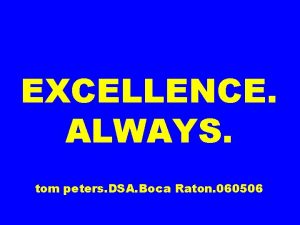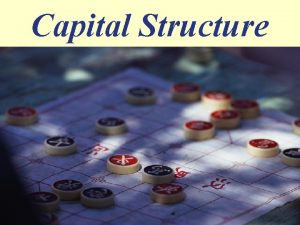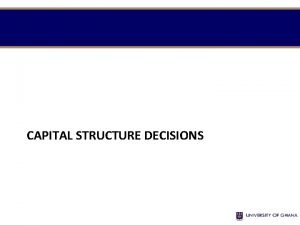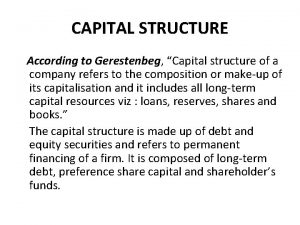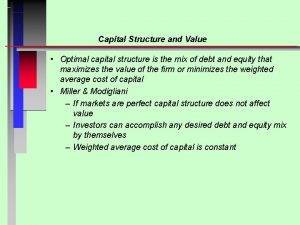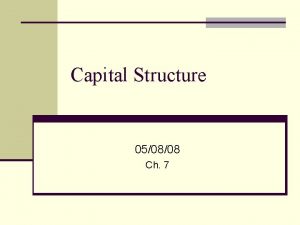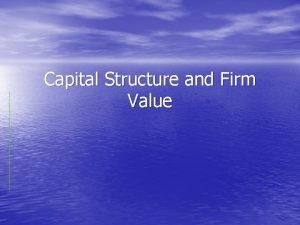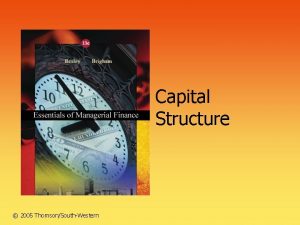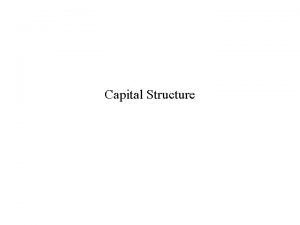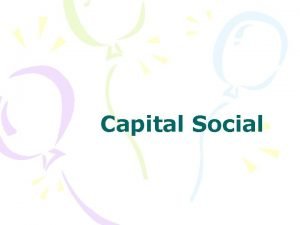Capital Structure Ch 12 060506 Capital structure The




















- Slides: 20

Capital Structure (Ch. 12) 06/05/06

Capital structure • The issues that we seek to address in this chapter are: How does a firm select its capital structure (debt-equity ratio)? Is there an optimal capital structure? • Considerations: – Financial leverage and its effect on firm value – Theories that may explain capital raising decisions • Pecking order theory • Miller and Modigliani (M&M) theories • Static theory of Finance

Quick review of capital markets • Capital markets represent sources for companies to raise long-term funds. These include bond and equity markets. • The return to the investor (provider of funds) is the firm’s (borrower) costs. • The rate that is charged to the borrower is a function of the riskiness of the proposed use of funds.

Quick review of capital markets • Bond markets tend to have the lowest returns, therefore this would represent the lowest cost of borrowing from the firm’s perspective. • Equity markets tend to have the highest returns, therefore this would represent the highest cost of borrowing from the firm’s perspective.

Financial leverage • Financial leverage refers to the extent to which a firm relies on debt financing. The more debt a firm uses, relative to equity, the more financial leverage it employs. • Generally, increases in leverage result in increases in risk and return, whereas decreases in leverage result in decreases in risk and return. • We can evaluate the impact of leverage on the owners of the firm by examining the firm’s Earnings per share (EPS).

Financial leverage • The breakeven earnings before interest and taxes (breakeven EBIT) is the level of earnings at which the firm and its owners are indifferent between the amount of debt and equity in its capital structure. • This occurs at the point where the return on equity (ROE) is the same as the cost of debt.

Pecking Order Theory • The pecking order theory suggests that there is an order of preference for the firm of capital sources when funding is needed. • The firm will seek to satisfy funding needs in the following order: – – Internal funds External funds • Debt • Equity

Pecking Order Theory • There are three factors that the pecking order theory is based on and that must be considered by firms when raising capital. 1. Internal funds are cheapest to use (no issuance costs) and require no private information release. 2. Debt financing is cheaper than equity financing.

Pecking Order Theory 3. Managers tend to know more about the future performance of the firm than lenders and investors. Because of this asymmetric information, investors may make inferences about the value of the firm based on the external source of capital the firm chooses to raise. 1. Equity financing inference – firm is currently overvalued 2. Debt financing inference – firm is correctly or undervalued

Pecking Order Theory • The pecking order theory suggests that the firm will first use internal funds. More profitable companies will therefore have less use of external sources of capital and may have lower debt-equity ratios. • If internal funds are exhausted, then the firm will issue debt until it has reached its debt capacity. • Only at this point will firms issue new equity. • This theory also suggests that there is no target debtequity mix for a firm.

Miller and Modigliani (M&M) theories of capital structure • Miller and Modigliani’s (M&M) seminal work on capital structure earned them Nobel prizes in Economics. • They assume that a firm can separate the investing (capital budgeting) decision from the financing decision. • The financing decision seeks to increase the value of the firm by selecting the best borrowing pattern for the firm.

M&M’s first theory: no taxes • M&M’s first theory assumes no taxes. • In this world, M&M conclude in Proposition I that capital structure is irrelevant: It does not matter how you finance your operations, the value of the firm is unchanged regardless and is based only on the investing choices of the firm.

M&M’s first theory: no taxes • We can use a simple (zero dividend growth) valuation model to understand the intuition behind and the implications of M&M’s first theory: If the cost of capital is unchanged and cash flows are unchanged, then the value of the firm is unchanged. • M&M’s proposition II provides the proof for theory. This proposition suggests that the cost of equity (Re) is a function of three things: the required return on the firm’s assets (WACC or R A), the cost of debt and the debt-equity ratio: Re = RA + (RA - Rd) (D/E)

M&M’s first theory: no taxes • This proof can be summarized with the following graph: Cost of capital Re = RA + (RA – Rd ) x (D/E) WACC = RA Rd Debt-equity ratio, D/E

M&M’s second theory: with taxes • M&M’s second theory introduces corporate taxes. • In this world, M&M conclude, in Proposition I, that the optimal capital structure is 100% debt.

M&M’s second theory: with taxes • The proof, Proposition II, shows that because interest payments are tax-deductible, the value of a levered firm (VL) increases with debt: VL = V E + T C * D where VE is the value of an all-equity firm and tc is the corporate tax rate and TC * D represents the tax shield.

Static theory of Finance • M&M’s second theory assumed that the cost of debt would remain the same regardless of how much debt the firm takes on. • However, as the firm assumes more debt, it becomes more risky, i. e. , will have a higher chance of defaulting on its debt and investors will therefore demand a higher return.

Static theory of Finance • When the possibility of bankruptcy and its associated costs are considered, the optimal capital structure (optimal debt-equity ratio ) is at the point where the additional tax-shield benefit of taking on one more dollar of debt (marginal benefit) is equal to the cost of bankruptcy (marginal cost).

Static theory of Finance Re Cost of capital WACC Re Rd Rd 0 Target Capital Structure Debt-equity ratio, D/E

Static theory of Finance Firm Value ($) V($) 0 Target Capital Structure Debt-equity ratio, D/E
 Multinational capital structure
Multinational capital structure Multinational cost of capital and capital structure
Multinational cost of capital and capital structure Hát kết hợp bộ gõ cơ thể
Hát kết hợp bộ gõ cơ thể Ng-html
Ng-html Bổ thể
Bổ thể Tỉ lệ cơ thể trẻ em
Tỉ lệ cơ thể trẻ em Chó sói
Chó sói Chụp tư thế worms-breton
Chụp tư thế worms-breton Chúa yêu trần thế alleluia
Chúa yêu trần thế alleluia Môn thể thao bắt đầu bằng chữ f
Môn thể thao bắt đầu bằng chữ f Thế nào là hệ số cao nhất
Thế nào là hệ số cao nhất Các châu lục và đại dương trên thế giới
Các châu lục và đại dương trên thế giới Công thức tiính động năng
Công thức tiính động năng Trời xanh đây là của chúng ta thể thơ
Trời xanh đây là của chúng ta thể thơ Cách giải mật thư tọa độ
Cách giải mật thư tọa độ 101012 bằng
101012 bằng Phản ứng thế ankan
Phản ứng thế ankan Các châu lục và đại dương trên thế giới
Các châu lục và đại dương trên thế giới Thể thơ truyền thống
Thể thơ truyền thống Quá trình desamine hóa có thể tạo ra
Quá trình desamine hóa có thể tạo ra Một số thể thơ truyền thống
Một số thể thơ truyền thống





















